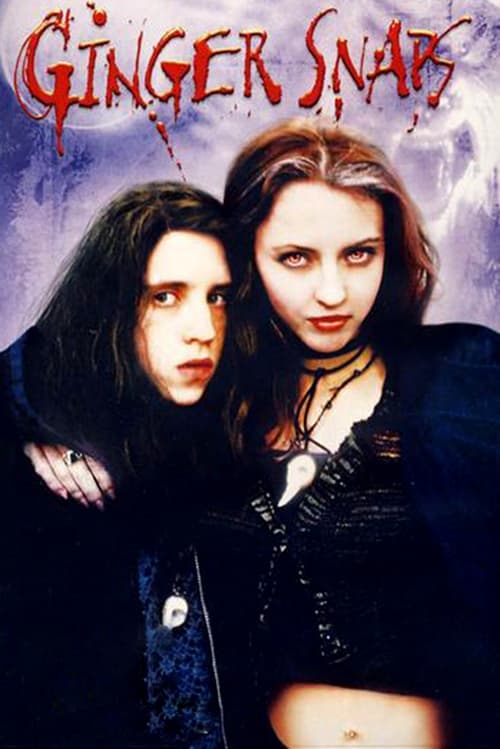Ginger Snaps – Film Review
Published April 20, 2024

When it comes to werewolf movies, Ginger Snaps (2000), directed by John Fawcett and written by Karen Walton, is a rare gem that stands out for its unique take on the sub-genre. More than two decades since its release, it remains not just a compelling horror flick but a poignant exploration of adolescence, sisterhood, and transformation. Through the story of two death-obsessed sisters, Brigitte and Ginger Fitzgerald, played with incredible chemistry by Emily Perkins and Katharine Isabelle respectively, Ginger Snaps transcends the traditional werewolf narrative to delve into themes of puberty, identity, and familial bonds.
The movie opens in the drab suburbs of Bailey Downs, introducing us to the Fitzgerald sisters who share a morbid fascination with death. This setup alone provides a fresh departure from typical horror premises by focusing on two complex female leads bonded by more than just familial ties. Their world takes a tumultuous turn when Ginger is attacked by a werewolf on the night of her first period, which brilliantly symbolizes the tumultuous nature of puberty. What follows is Ginger’s transformation, both physically into a werewolf and metaphorically into womanhood, paralleled with Brigitte’s desperate efforts to save her sister from this curse.
The genius of Ginger Snaps lies in its allegory of lycanthropy for puberty – a messy, violent, and confusing transformation. The film cleverly uses horror elements to explore the fear and isolation experienced during adolescence, particularly focusing on female puberty in a way rarely seen in cinema. This narrative choice not only gives the film a thematic depth but also enables it to address issues of body horror, sexuality, and societal expectations of femininity.
The performances in Ginger Snaps are among its strongest assets. Katharine Isabelle’s portrayal of Ginger’s metamorphosis from a sullen teenager to a menacing werewolf is both terrifying and tragic. She captures the internal struggle of her character with such conviction that the audience can’t help but empathize with Ginger, despite her increasingly animalistic behavior. On the other side, Emily Perkins gives a heartfelt performance as Brigitte, embodying the loyal sister caught in a harrowing situation. Her evolution from the shadow of her sister to the assertive protagonist is both believable and compelling. The dynamic between Perkins and Isabelle is the backbone of the film, portraying a sibling relationship that is deeply affectionate yet strained by Ginger’s transformation.
Cinematographer Thom Best utilizes a somber palette to underscore the film’s eerie atmosphere, which effectively complements the story’s dark themes. The suburban setting, usually perceived as safe and mundane, is rendered ominous, highlighting the horror lurking within the ordinary. The special effects, especially for the werewolf transformation, deserve praise for their practical ingenuity in an era before CGI dominance. Although some effects might appear dated by today’s standards, they contribute to the film’s gritty and visceral feel, enhancing the horror rather than detracting from it.
John Fawcett’s direction is deliberate, effectively balancing the horror elements with the story’s emotional core. He succeeds in maintaining suspense and tension throughout, keeping the audience invested in the sisters’ plight. Karen Walton’s screenplay is both sharp and insightful, injecting humor and wit into the dialogue that adds a layer of realism to the characters. Their collaboration brings to life a horror film that is both entertaining and thought-provoking.
The film’s soundtrack, composed by Michael Shields, subtly complements the onscreen action without overshadowing it. It enhances the overall mood, especially during the more suspenseful scenes, contributing to the film’s haunting atmosphere.
While Ginger Snaps is a remarkable film, it is not without its flaws. The pacing stumbles slightly in the middle, where the narrative occasionally drags, momentarily losing its tight grip on the audience’s attention. Additionally, some secondary characters are not as well-developed, serving more as plot devices than fully realized individuals. These minor criticisms, however, do not significantly detract from the overall impact and quality of the film.
Ginger Snaps stands as a testament to the potential of horror cinema to tell stories that are as deep and complex as they are frightening. Its exploration of adolescence through the lens of a werewolf curse is both unique and emotionally resonant, anchored by standout performances from its leads. The film cleverly subverts genre expectations, offering a narrative rich in themes and character development.
